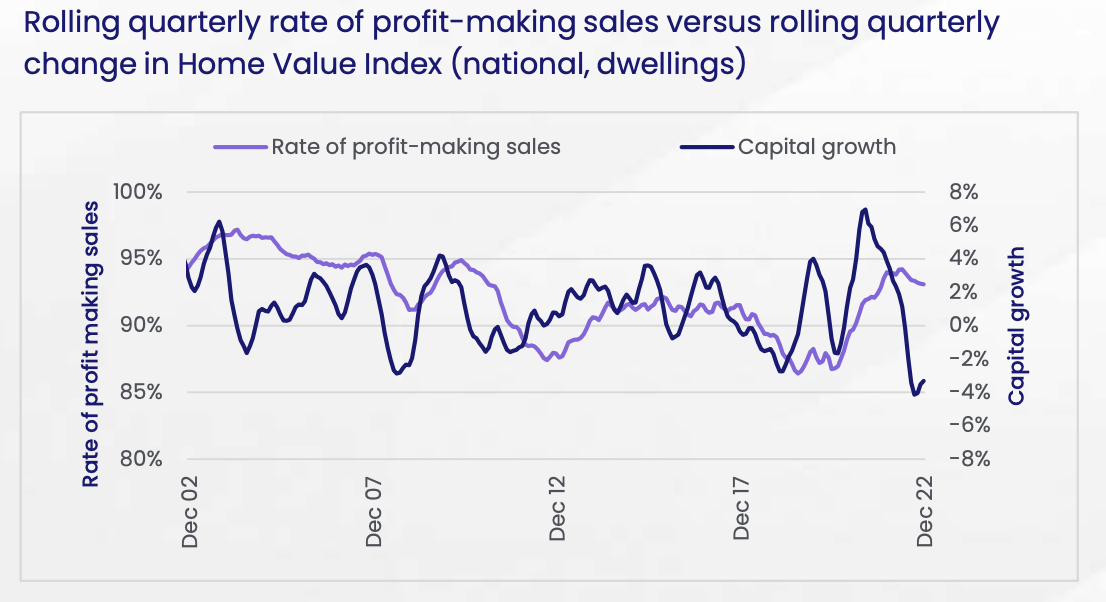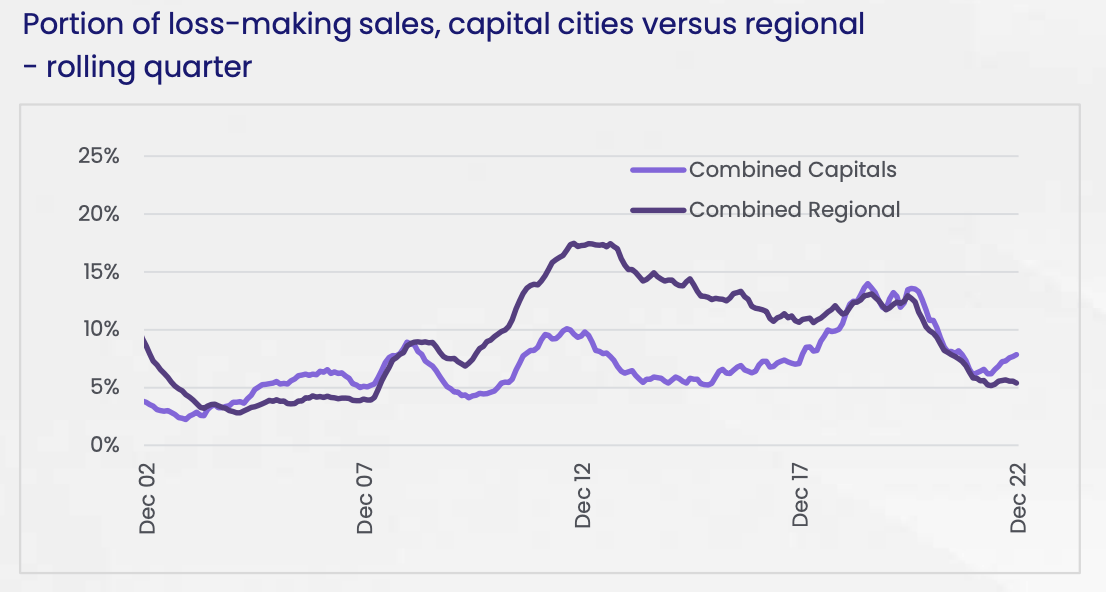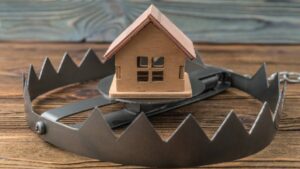Flipping is flopping: Aussie homeowners hold as short-term profits dive

Via Getty
It looks so easy on telly. Buy the worst house on the best street, patch up its structural issues with some masking tape and mid-price IKEA wall paper, et voila!
Flip that baby like a pancake and pocket the difference.
But no. The dream is over (or on pause).
CoreLogic’s latest report which they call Pain & Gain for reasons about to become obvious, suggests simply that our falling home values and our flustered, hesitant sellers are ensuring property is being held for longer while flippers and short-sellers are copping some rapidly diminishing profits.
It’s a big cohort to look at – CoreLogic’s December quarter analysis (of approximately 79,000 resales) is down some 7.3% on the previous quarter, while the portion of loss-making resales rose to 6.9%, up from a revised 6.6% in the three months to September.
CoreLogic’s statistical surgeon and head of research, Eliza Owen, says despite the increase of loss-making resales, the numbers are still below the previous decade average of 9.6%.
“With 93.1% of resales making a nominal gain, the vast majority of Australian homeowners who sold a property in the quarter did so with a gross profit,” she said.


“The decline in the volume of property sold in the final three months of 2022 reflects the reduced appetite for property purchases in the period, as well as fewer vendors being willing to sell in a weaker market.”
Check your address
The likelihood of a loss-making sale continues to vary greatly across different regions of Australia.
Broadly, Sydney and Melbourne have seen a more rapid increase in the rate of loss-making sales since national home values peaked in April last year.
Adelaide, Brisbane, Canberra and Hobart have also seen an uptick in the rate of loss-making sales, but the increase has been more gradual across these cities, and off a low base.
Perth and Darwin have elevated rates of loss-making sales, but these are consistently declining over time.
“The proportion of vendors selling for a loss remains relatively low, despite a rapid decline in home values in many markets. Though the underlying cash rate target increased 300 basis points between April and December 2022, homeowners increasingly opted not to sell in the current downswing,” Owen noted.
The combined value of nominal gains from resale over the three months to December was $25.1 billion, down from a revised $27.1 billion in the September quarter (-7.3%). The combined value of loss-making sales also declined in the quarter, to $241.4 million (-4.9%).
The median nominal gain from resale was $256,000 in the December quarter, down from $290,000 in the previous quarter, while the median loss was $40,500 up slightly from $40,000 in the September quarter.
Ms Owen said key trends in the Q4 report included the increase in the median hold period for resales, which lifted to 9.9 years nationally, compared to 9.2 years in the September quarter and the decline in short-term gains.
“The opportunity for very short-term gains in the property market have notably shifted from the windfalls of early 2022,” she said.
“One in 10 loss-making resales nationally were on properties owned for two years or less. For those who resold for a profit within two years of purchase, the nominal gains were $94,000. That’s still a strong result but it’s a significant decline from the $170,000 gains being achieved in the March 2022 quarter from properties purchased amid the onset of COVID-19.”
Houses vs Units
The difference between house and unit loss-making resales have recorded a 10.35 percentage point gap, one of the largest discrepancies on record. Ms Owen said not only did houses have a much greater incidence of making a nominal gain, but median gains were more than twice that of units, at $350,000 compared with $145,000.
“Since the start of the current cycle in late 2020 through to December 2022, national house values were 20.9% higher, and unit values only 10.1% higher. After a turbulent cycle, houses ended up with higher value gains, which helps to explain why the rate of loss-making house sales is so much lower than what’s occurring across the unit segment,” she said.
Regional markets
Recent regional market value falls are starting to translate to an increase in the rate of loss-making sales in some lifestyle markets of Australia, albeit off very low incidences of loss. Across the combined ‘sea change’ markets, the rate of loss-making sales increased by less than 1% in the quarter across the Mid-North Coast, Newcastle, the Gold Coast and the Sunshine Coast.
The rate of loss-making sales increased by around 100 basis points across Richmond-Tweed, while profit-making sales rates increased across Bunbury, Cairns, Geelong and the Illawarra. Across each of these markets, the rate of profit-making sales remained above 90%, and the rate of profit-making sales across Geelong, the Sunshine Coast and Illawarra was 99% in the quarter.
Pain & Gain Outlook
Australian home values have shown signs of stabilising in the first half of March 2023 with CoreLogic’s Daily Home Value Index across the combined five largest capital cities increasing 0.3%.
Ms Owen said it is too soon to say whether the housing market downturn has bottomed out, but a slowdown in the pace of housing value declines usually also corresponds with a slowdown in the rate of loss-making sales.
“While the rate of loss-making sales may show an increase in the coming quarters, the jump may not be as substantial as the 30 basis point increase over the December quarter,” she said.
“An improvement in housing market conditions is broadly expected in the second half of 2023 and into 2024 on the presumption the RBA will have finished lifting rates by this time. If that occurs, the market may give way to a rise in housing demand amid improved consumer confidence and the strong return of overseas migration.
“Any upward pressure on home values would broadly increase the chance of making a nominal gain from resales. This could also see the housing market cycle move through the largest national downswing on record, without hitting record levels of loss-making sales.”
Key findings for Pain & Gain, December Quarter 2022
- CoreLogic analysed approximately 79,000 dwelling resales in the December 2022 quarter
- The incidence of profit-making sales nationally declined to 93.1%, down slightly on the results from the September 2022 quarter
- Profit-making resales hit a recent high of 94.2% in May 2022, on a rolling three-month basis
- Across the greater capital city and rest of state regions, eight out of 15 markets saw an increase in the rate of loss-making resales
- Melbourne had the largest quarterly increase in the rate of loss-making resales, jumping from 6.7% to 8.0%
- Perth once again had the highest volume of loss-making resales, accounting for almost 20% of the loss-making sales nationally
- Adelaide had the highest incidence of houses sold for a nominal gain at 99%
- The discrepancy between house and unit loss-making resales is one of the largest on record, at 10.35 percentage points
- Not only did houses have a much greater incidence of making a nominal gain, but median gains were more than twice that of units, at $350,000 compared with $145,000
- Nationally the median hold period for resales increased to 9.9 years compared to 9.2 years in the September quarter.
Related Topics
UNLOCK INSIGHTS
Discover the untold stories of emerging ASX stocks.
Daily news and expert analysis, it's free to subscribe.
By proceeding, you confirm you understand that we handle personal information in accordance with our Privacy Policy.








